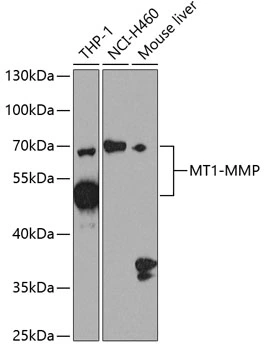MMP14 antibody
GTX11621
ApplicationsWestern Blot, ELISA, ImmunoHistoChemistry, ImmunoHistoChemistry Paraffin
Product group Antibodies
TargetMMP14
Overview
- SupplierGeneTex
- Product NameMMP14 antibody
- Delivery Days Customer9
- Application Supplier NoteWB: 1:100-1:500. IHC-P: 1:50-1:100. ELISA: 1:1,000. *Optimal dilutions/concentrations should be determined by the researcher.Not tested in other applications.
- ApplicationsWestern Blot, ELISA, ImmunoHistoChemistry, ImmunoHistoChemistry Paraffin
- CertificationResearch Use Only
- ClonalityPolyclonal
- Concentration0.5 mg/ml
- ConjugateUnconjugated
- Gene ID4323
- Target nameMMP14
- Target descriptionmatrix metallopeptidase 14
- Target synonymsmatrix metallopeptidase 14 (membrane-inserted); matrix metalloproteinase-14; membrane type 1 metalloprotease; membrane-type-1 matrix metalloproteinase; MMP-14; MMP-X1; MT1MMP; MT1-MMP; MT-MMP; MT-MMP 1; MTMMP1; WNCHRS
- HostRabbit
- IsotypeIgG
- Protein IDP50281
- Protein NameMatrix metalloproteinase-14
- Scientific DescriptionThe matrix metalloproteinases (MMPs) are a family of at least eighteen secreted and membrane bound zincendopeptidases. Collectively, these enzymes can degrade all the components of the extracellular matrix, including fibrillar and non fibrillar collagens, fibronectin, laminin and basement membrane glycoproteins. In general, a signal peptide, a propeptide, and a catalytic domain containing the highly conserved zinc binding site characterizes the structure of the MMPs. In addition, fibronectin like repeats, a hinge region, and a C terminal hemopexin like domain allow categorization of MMPs into the collagenase, gelatinase, stomelysin and membrane-type MMP subfamilies. All MMPs are synthesized as proenzymes, and most of them are secreted from the cells as proenzymes. Thus, the activation of these proenzymes is a critical step that leads to extracellular matrix breakdown. MMPs are considered to play an important role in wound healing, apoptosis, bone elongation, embryo development, uterine involution, angiogenesis and tissue remodeling, and in diseases such as multiple sclerosis, Alzheimer s, malignant gliomas, lupus, arthritis, periodontis, glumerulonephritis, atherosclerosis, tissue ulceration, and in cancer cell invasion and metastasis.
- Storage Instruction-20°C or -80°C,2°C to 8°C
- UNSPSC12352203


![IHC-P analysis of formalin fixed human placenta tissue using GTX52480 MMP14 antibody [9E10].](https://www.genetex.com/upload/website/prouct_img/normal/GTX52480/GTX52480_20191119_IHC-P_w_23060900_536.webp)

